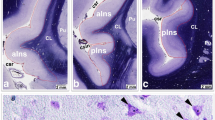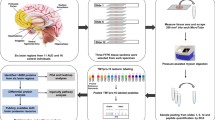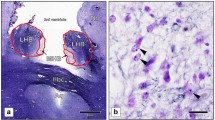Abstract
Besides the ventral tegmental area and the nucleus accumbens as the most investigated brain reward structures, several reports about the relation between volume and activity of the amygdala and drug-seeking behavior have emphasized the central role of the amygdala in the etiology of addiction. Considering its proposed important role and the limited number of human protein expression studies with amygdala in drug addiction, we performed a human postmortem proteomic analysis of amygdala tissue obtained from 8 opiate addicts and 7 control individuals. Results were validated by Western blot in an independent postmortem replication sample from 12 opiate addicts compared to 12 controls and 12 suicide victims, as a second “control sample”. Applying 2D-electrophoresis and MALDI–TOF–MS analysis, we detected alterations of beta-tubulin expression and decreased levels of the heat-shock protein HSP60 in drug addicts. Western blot analysis in the additional sample demonstrated significantly increased alpha- and beta-tubulin concentrations in the amygdala of drug abusers versus controls (P = 0.021, 0.029) and to suicide victims (P = 0.006, 0.002). Our results suggest that cytoskeletal alterations in the amygdala determined by tubulin seem to be involved in the pathophysiology of drug addiction, probably via a relation to neurotransmission and cellular signaling. Moreover, the loss of neuroprotection against stressors by chaperons as HSP60 might also contribute to structural alteration in the brain of drug addicts. Although further studies have to confirm our results, this might be a possible pathway that may increase our understanding of drug addiction.



Similar content being viewed by others
References
Koob GF, LeMoal M (1997) Drug abuse: hedonic homeostatic dysregulation. Science 278:52–58
Goodman A (2008) Neurobiology of addiction. An integrative review. Biochem Pharmacol 75:266–322
Hurd YL (2006) Perspectives on current directions in the neurobiology of addiction disorders relevant to genetic risk factors. CNS Spectr 11:855–862
Di CG, Bassareo V (2007) Reward system and addiction: what dopamine does and doesn’t do. Curr Opin Pharmacol 7:69–76
Heidbreder CA, Gardner EL, Xi ZX, Thanos PK, Mugnaini M, Hagan JJ, Ashby CR Jr (2005) The role of central dopamine D3 receptors in drug addiction: a review of pharmacological evidence. Brain Res Brain Res Rev 49:77–105
Przewlocki R (2004) Opioid abuse and brain gene expression. Eur J Pharmacol 500:331–349
Koob GF, LeMoal M (2001) Drug addiction, dysregulation of reward, and allostasis. Neuropsychopharmacology 24:97–129
Nestler EJ (2005) Is there a common molecular pathway for addiction? Nat Neurosci 8:1445–1449
Koob GF, LeMoal M (2005) Plasticity of reward neurocircuitry and the ‘dark side’ of drug addiction. Nat Neurosci 8:1442–1444
Koob GF, LeMoal M (2008) Review. Neurobiological mechanisms for opponent motivational processes in addiction. Philos Trans R Soc Lond B Biol Sci 363:3113–3123
McClung CA, Nestler EJ (2008) Neuroplasticity mediated by altered gene expression. Neuropsychopharmacology 33:3–17
Bechara A, Damasio H, Damasio AR, Lee GP (1999) Different contributions of the human amygdala and ventromedial prefrontal cortex to decision-making. J Neurosci 19:5473–5481
Winstanley CA, Theobald DE, Cardinal RN, Robbins TW (2004) Contrasting roles of basolateral amygdala and orbitofrontal cortex in impulsive choice. J Neurosci 24:4718–4722
von der Goltz C, Kiefer F (2009) Learning and memory in the aetiopathogenesis of addiction: future implications for therapy? Eur Arch Psychiatry Clin Neurosci 259(2):S183–S187
See RE, Fuchs RA, Ledford CC, McLaughlin J (2003) Drug addiction, relapse, and the amygdala. Ann N Y Acad Sci 985:294–307
Makris N, Gasic GP, Seidman LJ, Goldstein JM, Gastfriend DR, Elman I, Albaugh MD, Hodge SM, Ziegler DA, Sheahan FS, Caviness VS Jr, Tsuang MT, Kennedy DN, Hyman SE, Rosen BR, Breiter HC (2004) Decreased absolute amygdala volume in cocaine addicts. Neuron 44:729–740
Wrase J, Makris N, Braus DF, Mann K, Smolka MN, Kennedy DN, Caviness VS, Hodge SM, Tang L, Albaugh M, Ziegler DA, Davis OC, Kissling C, Schumann G, Breiter HC, Heinz A (2008) Amygdala volume associated with alcohol abuse relapse and craving. Am J Psychiatry 165:1179–1184
Koob GF (2009) Brain stress systems in the amygdala and addiction. Brain Res 13:61–75
Taurines R, Dudley E, Conner AC, Grassl J, Jans T, Guderian F, Mehler-Wex C, Warnke A, Gerlach M, Thome J (2010) Serum protein profiling and proteomics in autistic spectrum disorder using magnetic bead-assisted mass spectrometry. Eur Arch Psychiatry Clin Neurosci 260:249–255
Brunner J, Bronisch T, Uhr M, Ising M, Binder E, Holsboer F, Turck CW (2005) Proteomic analysis of the CSF in unmedicated patients with major depressive disorder reveals alterations in suicide attempters. Eur Arch Psychiatry Clin Neurosci 255:438–440
Gorg A, Obermaier C, Boguth G, Harder A, Scheibe B, Wildgruber R, Weiss W (2000) The current state of two-dimensional electrophoresis with immobilized pH gradients. Electrophoresis 21:1037–1053
Shevchenko A, Wilm M, Vorm O, Mann M (1996) Mass spectrometric sequencing of proteins silver-stained polyacrylamide gels. Anal Chem 68:850–858
Tebbe A, Klein C, Bisle B, Siedler F, Scheffer B, Garcia-Rizo C, Wolfertz J, Hickmann V, Pfeiffer F, Oesterhelt D (2005) Analysis of the cytosolic proteome of Halobacterium salinarum and its implication for genome annotation. Proteomics 5:168–179
Perkins DN, Pappin DJ, Creasy DM, Cottrell JS (1999) Probability-based protein identification by searching sequence databases using mass spectrometry data. Electrophoresis 20:3551–3567
Kim SY, Chudapongse N, Lee SM, Levin MC, Oh JT, Park HJ, Ho IK (2005) Proteomic analysis of phosphotyrosyl proteins in morphine-dependent rat brains. Brain Res Mol Brain Res 133:58–70
Matsumoto I, exander-Kaufman K, Iwazaki T, Kashem MA, Matsuda-Matsumoto H (2007) CNS proteomes in alcohol and drug abuse and dependence. Expert Rev Proteomics 4:539–552
Neasta J, Uttenweiler-Joseph S, Chaoui K, Monsarrat B, Meunier JC, Mouledous L (2006) Effect of long-term exposure of SH-SY5Y cells to morphine: a whole cell proteomic analysis. Proteome Sci 4:23
Tannu N, Mash DC, Hemby SE (2007) Cytosolic proteomic alterations in the nucleus accumbens of cocaine overdose victims. Mol Psychiatry 12:55–73
Marie-Claire C, Courtin C, Roques BP, Noble F (2004) Cytoskeletal genes regulation by chronic morphine treatment in rat striatum. Neuropsychopharmacology 29:2208–2215
Boudreau AC, Ferrario CR, Glucksman MJ, Wolf ME (2009) Signaling pathway adaptations and novel protein kinase A substrates related to behavioral sensitization to cocaine. J Neurochem 110:363–377
Verdier-Pinard P, Pasquier E, Xiao H, Burd B, Villard C, Lafitte D, Miller LM, Angeletti RH, Horwitz SB, Braguer D (2009) Tubulin proteomics: towards breaking the code. Anal Biochem 384:197–206
Verdejo-Garcia A, Perez-Garcia M, Sanchez-Barrera M, Rodriguez-Fernandez A, Gomez-Rio M (2007) Neuroimaging and drug addiction: neuroanatomical correlates of cocaine, opiates, cannabis and ecstasy abuse. Rev Neurol 44:432–439
Howe CL, Mobley WC (2004) Signaling endosome hypothesis: a cellular mechanism for long distance communication. J Neurobiol 58:207–216
Collins MO, Yu L, Coba MP, Husi H, Campuzano I, Blackstock WP, Choudhary JS, Grant SG (2005) Proteomic analysis of in vivo phosphorylated synaptic proteins. J Biol Chem 280:5972–5982
Poulain FE, Sobel A (2009) The microtubule network and neuronal morphogenesis: dynamic and coordinated orchestration through multiple players. Mol Cell Neurosci 43(1):15–21
Signor D, Scholey JM (2000) Microtubule-based transport along axons, dendrites and axonemes. Essays Biochem 35:89–102
Russo SJ, Mazei-Robison MS, Ables JL, Nestler EJ (2009) Neurotrophic factors and structural plasticity in addiction. Neuropharmacology 56(1):73–82
Thomas MJ, Kalivas PW, Shaham Y (2008) Neuroplasticity in the mesolimbic dopamine system and cocaine addiction. Br J Pharmacol 154:327–342
Geremia NM, Pettersson LM, Hasmatali JC, Hryciw T, Danielsen N, Schreyer DJ, Verge VM (2009) Endogenous BDNF regulates induction of intrinsic neuronal growth programs in injured sensory neurons. Exp Neurol 223(1):128–142
Gordon T (2009) The role of neurotrophic factors in nerve regeneration. Neurosurg Focus 26(2):E3
Rasenick MM, Donati RJ, Popova JS, Yu JZ (2004) Tubulin as a regulator of G-protein signaling. Methods Enzymol 390:389–403
Popova JS, Rasenick MM (2003) G beta gamma mediates the interplay between tubulin dimers and microtubules in the modulation of Gq signaling. J Biol Chem 278:34299–34308
Popova NK, Naumenko KS, Maslova LN, Amstislavskaya TG, Melidi NN, Bulygina VV, Ivanova LN (2002) Hypothalamic tryptophan hydroxylase and the hypothalamic-pituitary-adrenocortical response to water deprivation and hydration in vasopressin-deficient and normal rats. Pflugers Arch 444:372–377
Gupta RS (1995) Evolution of the chaperonin families (Hsp60, Hsp10 and Tcp-1) of proteins and the origin of eukaryotic cells. Mol Microbiol 15:1–11
Cunha-Oliveira T, Rego AC, Oliveira CR (2008) Cellular and molecular mechanisms involved in the neurotoxicity of opioid and psychostimulant drugs. Brain Res Rev 58:192–208
Hayase T, Yamamoto Y, Yamamoto K, Muso E, Shiota K, Hayashi T (2003) Similar effects of cocaine and immobilization stress on the levels of heat-shock proteins and stress-activated protein kinases in the rat hippocampus, and on swimming behaviors: the contribution of dopamine and benzodiazepine receptors. Behav Pharmacol 14:551–562
Salminen WF Jr, Voellmy R, Roberts SM (1997) Protection against hepatotoxicity by a single dose of amphetamine: the potential role of heat shock protein induction. Toxicol Appl Pharmacol 147:247–258
Salminen WF Jr, Roberts SM, Fenna M, Voellmy R (1997) Heat shock protein induction in murine liver after acute treatment with cocaine. Hepatology 25:1147–1153
Stan AD, Ghose S, Gao XM, Roberts RC, Lewis-Amezcua K, Hatanpaa KJ, Tamminga CA (2006) Human postmortem tissue: what quality markers matter? Brain Res 1123:1–11
Conflict of interest
None.
Author information
Authors and Affiliations
Corresponding author
Rights and permissions
About this article
Cite this article
Zill, P., Vielsmeier, V., Büttner, A. et al. Postmortem proteomic analysis in human amygdala of drug addicts: possible impact of tubulin on drug-abusing behavior. Eur Arch Psychiatry Clin Neurosci 261, 121–131 (2011). https://doi.org/10.1007/s00406-010-0129-7
Received:
Accepted:
Published:
Issue Date:
DOI: https://doi.org/10.1007/s00406-010-0129-7




